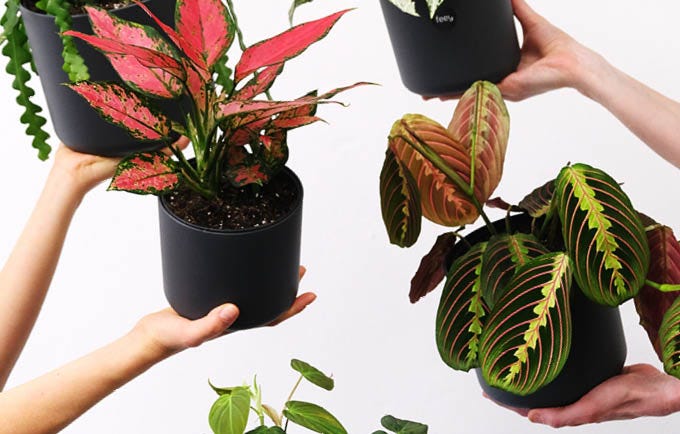Gardens are a gateway to nature, allowing us to connect with the elements around us. While we can appreciate their beauty, sometimes we overlook their other properties. That’s why sensory gardens are so important. They make us more aware of our surroundings and our responses to them.
If you’re looking to change up your garden for spring or are interested in exploring some sensory garden ideas, keep on reading as we walk you through everything you need to know.

What is a sensory garden?
As the name suggests, a sensory garden is grown with one goal in mind - to stimulate the five senses. While some gardens are planted for the fruit that they bear or for the colour schemes that they create, sensory gardens have an array of features that engage our sense of sight, smell, sound, touch and taste..
What are the benefits of a sensory garden?
As they affect us in a range of different ways, sensory gardens can be used for a number of purposes. The most obvious benefit is that they help us to connect with nature. In busy urban areas where there might not be many green spaces, having a sensory garden or balcony allows people to engage with their natural surroundings.
They enhance our sense of wellbeing, foster a feeling of mindfulness, de-stress and bring calm. Sensory gardens can be a place for community, for growing fruits and vegetables and for learning. They can be therapeutic and healing, a retreat from busy lifestyles or simply just a place to sit and read a book.
The tactile environment of these gardens make them the perfect safe place for children, the elderly or anyone looking for extra sensory stimulation amongst nature.
Sensory garden ideas to try at home

Sight
For a garden full of vivid colours and shapes all year round, plant tactically. Flowers like tulips, poppies, marigolds, purple coneflowers and daisies will bloom in spring and summer to bring vibrant, cheerful hues. To keep visual intrigue in the winter months, small trees like the corylus avellana 'Red Majestic' will add rich pockets of colour. The Algerian iris also flowers in winter, as do the small berries of the skimmia shrub.
Plants with striking patterns and designs will create an even more diverse sensory display. Persian shields and fan plants have unique leaves that stand out against block colours.
Taller shrubs and bushes like the evergreen holly-leaved sweet spire and wintergreen barberry add structure and can form the backbone to your garden. Shrubs are generally very easy to maintain and their towering height adds visual contrast against low growing flowers. Climbing foliage like honeysuckle and clematis cling to fences and trellises. They bloom pretty flowers and provide natural movement when the wind blows.
And it’s not just plant life that can bring stunning visuals to a sensory garden. Pollinating insects like bees, wasps and butterflies bring an extra dimension to your outdoor spaces, as well as supporting the ecosystem. Invite them with pollinator friendly plants like sunflowers, cosmos, roses, and lavender.
When night falls you can still enjoy visuals from your garden, despite the lack of sunlight. Nocturnal insects like glow-worms are active in the summer months in many parts of the world. Turn down your garden lights to view these luminous beetles.

Sound
The sounds of nature can be heard from a range of different elements. Leafy plants like bamboo stems and ornamental grasses create a soothing rustling sound in the wind.
To stimulate this sense further, try incorporating a water element into your garden. Small garden fountains or features allow the gentle trickle of running water to be heard.
Encourage bird activity with a bird bath or feeder. Their tweets and songs add a musical element to your aural landscape.
Lots of natural noises can be heard in the garden, but you can also use man made objects to allow for contrast. Lay down crunchy gravel, small stones and pebbles or slate chippings. Place these on top of planters, use them to fill in the empty spaces between flower beds or create a little pathway with them. Or why not hang a windchime for melodic effect?

Smell
The sense of smell is incredibly powerful and can trigger lots of memories and emotions. Thankfully, the garden is a bountiful landscape of natural aromas.
Plant an array of aromatic plants like jasmine, lavender, roses and honeysuckle. These flower species have strong scents that can be appreciated from a distance. Other flowers like peonies, butterfly weed and yarrow can stimulate the senses from a closer range.
If you’re sensitive to strong floral scents, try growing herbs for a different type of fragrance. Mint, sage and rosemary are excellent options. They also create a multi-sensory experience too, as they smell and taste wonderful.
Other options for engaging your sense of smell are freshly cut grass, bark chippings and compost. These offer an earthy scent that can be less overwhelming for some.

Touch
When it comes to touch, there’s no shortage of tactile surfaces to enjoy in the garden. From glossy leaves to delicate petals, there’s a world of texture to explore at your fingertips.
Lamb’s ear plants are a firm favourite and can be addictive to touch thanks to their wooly, furry leaves. They also sprout spikes of flowers that bloom in the summer too, which offer a contrasting sensory feel.
Pampas grass also has another unique texture. This ornamental grass is visually stunning, but its creamy plumes can also be ticklish to touch. They’re extremely hardy and can be dried to appreciate indoors too.
For softer surfaces, succulents are a great choice. Graptopetalum and the round-leafed navel-wort have larger leaves than most succulents, making them ideal for feeling their soft exteriors. While these can thrive happily outdoors in warmer temperatures, it’s recommended to bring them indoors during the winter.
And finally, rough tree seed pods from acorn and sycamore trees offer a more abrasive sensation. Fallen pine cones and crunchy leaves in autumn are famously textured and appear in rich, golden colours that are a feast for the eyes too.

Taste
Tease your tastebuds with nature’s finest produce. Growing fruits and vegetables in an outdoor patch or greenhouse can be a long process but it’s rewarding. Even for brown-fingered gardeners, there are plenty of resilient options that require little skill. If you’re dabbling into the world of gardening for the first time, salad leaves, potatoes, strawberries, radishes and peas are all beginner-friendly foods.
For a more fragrant taste experience, why not opt to grow herbs instead? Parsley, oregano, thyme and dill are great starting herbs. And they can even be grown from your kitchen windowsill if you’re short on space, or a balcony if you don’t have a garden.
A more unusual way to invigorate your sense of taste in the garden is to grow edible flowers. Did you know that some common varieties of dandelion, rose, bergamot, chamomile, marigold and pansy flowers can be safely consumed? Use them for garnishing or steeping into a herbal tea.
On a final note, gardens encourage a whole manner of plants to bloom and bear fruit, however not all of them are safe to eat. Always be cautious of which fruits and vegetables you can consume in your garden.
We might’ve listed all of our favourite sensory garden ideas, but don’t feel pressured to have to try all of them. The goal of a sensory garden is to be able to tune into nature and engage each of your senses, however that may be. Choose what works for you and what you’d like to experience in your own sensory garden.
Looking for more ways to dress your garden? Take a browse at our garden candles and outdoor candle holders. Or, explore refreshing seasonal fragrance from our latest collectionhere.













